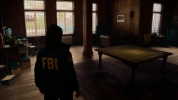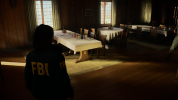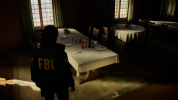Changes absolutely nothing about what I said. Drawing some strict line between non and mesh-shading supported GPU's was clearly not a correct way to view things given these new results.We have a whole forum dedicated to this
You are using an out of date browser. It may not display this or other websites correctly.
You should upgrade or use an alternative browser.
You should upgrade or use an alternative browser.
Digital Foundry Article Technical Discussion [2023]
- Thread starter BRiT
- Start date
- Status
- Not open for further replies.
We have a literal forum of people that have come together to discuss the various differences here. Even Alex writes about it here:Changes absolutely nothing about what I said. Drawing some strict line between non and mesh-shading supported GPU's was clearly not a correct way to view things given these new results.
PS5 Mesh Shaders are not DX spec.

Direct3D Mesh Shaders
“On PlayStation 5 we use primitive shaders for that path which is considerably faster than using the old pipeline we had before with vertex shaders.” Yea there are a couple of discussions floating about here about PrSh and NGG. and RDNA1/2 support etc. The NGG is a driver path that compiles the...
And why you need RDNA2 for DX Mesh Shaders

Direct3D Mesh Shaders
“On PlayStation 5 we use primitive shaders for that path which is considerably faster than using the old pipeline we had before with vertex shaders.” Yea there are a couple of discussions floating about here about PrSh and NGG. and RDNA1/2 support etc. The NGG is a driver path that compiles the...
I think remedy deciding to write a mesh shader only pipeline (and stop making changes to the old fallback version) is a big endorsement of mesh shading as an api feature. Whatever they're doing with the mesh shaders, I'm perfectly confident they could get running in a performant enough for current hardware way on any console api from the last 10 years. Nobody has had (show stopping) trouble writing gpu driven renderers since the xbox one/ps4 gen. I'd expect the performance gap, and the scalability onto the series S, has more to do with this being a modern, compute heavy, gpu driven renderer than some api features.
Changes absolutely nothing about what I said. Drawing some strict line between non and mesh-shading supported GPU's was clearly not a correct way to view things given these new results.
Are you suggesting AW2 is taking advantage of RDNA1 primitive shader hardware somehow? Using which api?
Take it up with him in his recent video then. Obviously he had views before that dont hold up now that he's actually talked to professionals about it.We have a literal forum of people that have come together to discuss the various differences here. Even Alex writes about it here:
Not that you guys are the gospel about any such subject anyways.
Why are you arguing this? I dont get it. Alex is literally not supporting what you're saying anymore. This isn't complicated and I dont understand what you're insisting on being so stubborn about learning that there's obviously some middle ground here that y'all hadn't considered before.
No, I am not claiming that personally. That is what Alex said when he talked to an actual developer from Remedy. You are free to take it up with him, but I still find it absolutely bizarre why some of you are incredibly resistant to this and are taking up any argument tactic you think might work to deny it. Actually, that's a lie. I know exactly why some of you are doing it...Are you suggesting AW2 is taking advantage of RDNA1 primitive shader hardware somehow? Using which api?
No, I am not claiming that personally. That is what Alex said when he talked to an actual developer from Remedy. You are free to take it up with him, but I still find it absolutely bizarre why some of you are incredibly resistant to this and are taking up any argument tactic you think might work to deny it. Actually, that's a lie. I know exactly why some of you are doing it...
I don't know what Alex said or what resistance you're talking about. I didn't understand your last few posts so hence asked the question.
I don't know what Alex said or what resistance you're talking about. I didn't understand your last few posts so hence asked the question.
Last edited:
I think what _all_ of us are trying to say is that what Alex says in this video does not invalidate what we have written, but validates it.Take it up with him in his recent video then. Obviously he had views before that dont hold up now that he's actually talked to professionals about it.
Not that you guys are the gospel about any such subject anyways.
Why are you arguing this? I dont get it. Alex is literally not supporting what you're saying anymore. This isn't complicated and I dont understand what you're insisting on being so stubborn about learning that there's obviously some middle ground here that y'all hadn't considered before.
That thread talks about RDNA 1 having Primitive Shaders. It covers PS5 having Primitive Shaders. It covers that they do not have Amplification shaders. It covers the subtle difference between Primitive Shader and a Mesh Shader (which there is 1 only discernable difference).
Nothing Alex has said in this video goes against anything anyone has written.
My only guess would be that AMD does something driver side since devs have no access to NGG on Vega or RDNA 1.Timestamped and though I don't think anyone is arguing here, we are just trying to figure out how the RX5700 is still "playable" despite not having DX Mesh Shader support.
Timestamped and though I don't think anyone is arguing here, we are just trying to figure out how the RX5700 is still "playable" despite not having DX Mesh Shader support.
Thanks but I don’t get the connection between anything Alex said there and the 5700XT. Primitive shaders are accessible on PS5 but how is that relevant to RDNA1 on PC?
Btw I noticed Alex sounds very different on recent videos. Rich sounds different too in this last video. Is DF doing something funky with audio processing or are my ears starting to give out?
That is a real possibility, I could swear I read something about AMD doing something in the driver somewhere but I have not been able to find it.My only guess would be that AMD does something driver side since devs have no access to NGG on Vega or RDNA 1.
amplification shader step is optionalIt’s a primitive shader.
When people refer to mesh shaders on directX; they are talking about both amplification and mesh shader.
On PS5, they only have a primitive shader which aligns with the mesh shader, they are missing an amplification shader, which means developers have to do it.
It’s not a bad thing, and we have seen examples in the past: see UE5 Nanite uses compute shaders and mesh/primitive shaders. But it is on the developer to do which is why I don’t think it’s often used.
What does an Amplification Shader do?
While the Mesh Shader is a fairly flexible tool, it does not allow for all tessellation scenarios and is not always the most efficient way to implement per-instance culling. For this we have the Amplification Shader. What it does is simple: dispatch threadgroups of Mesh Shaders. Each Mesh Shader has access to the data from the parent Amplification Shader and does not return anything. The Amplification Shader is optional, and also has access to groupshared memory, making it a powerful tool to allow the Mesh Shader to replace any current pipeline scenario.

Coming to DirectX 12— Mesh Shaders and Amplification Shaders: Reinventing the Geometry Pipeline - DirectX Developer Blog
D3D12 is adding two new shader stages: the Mesh Shader and the Amplification Shader. These additions will streamline the rendering pipeline, while simultaneously boosting flexibility and efficiency. In this new and improved pre-rasterization pipeline, Mesh and Amplification Shaders will...
 devblogs.microsoft.com
devblogs.microsoft.com
Gave Alan Wake a super quick look today on PC. Looks nice overall and performs well on a 4090. I didn't bring up a frame counter but felt smooth with everything maxed at 1440p DLSS quality (no frame interp). Probably could have gone to DLAA to be honest, at least in the sections I played.
The foliage stuff at the start looked a little flat but may have been art style things. Interiors in the town look pretty nice, but ran into some interesting things.
1) Ray reconstruction ghosting is present, but not nearly as bad as cyberpunk, at least in the areas I checked. This may relate to the next point...
2) It seems like even with full RT/PT enabled, there's perhaps still some amount of baked lighting "under" it all? For instance, here's a shot from inside one of the buildings with a big bay window acting as an area light off the left of the camera. The shadow from the pole never gets sharp even at the contact point, displays quantization/aliasing and does not change at all when you toggle RT/PT on/off:

Also note that the main character doesn't cast a shadow from this light source, leading me to believe it's not a real light source in the RT scene, but indeed the contribution is baked. (Edit: just skimmed the DF tech article as well and they mention the same thing, so seems to be confirmed.)
If you angle the camera to look at the specular reflection, it's clear that RT is being used for that at least (toggling off/on), but the direct lighting here is not affected by the settings at all:
No RT reflection:

RT reflection:

If a chunk of the indirect lighting is coming from baked surfaces that might help explain why the PT indirect lighting doesn't have as large a visual effect as in Cyberpunk (at least in the areas I've found), and why it doesn't have as many ghosting issues.
In any case there's nothing wrong with baking when the lighting setup is static and known in advance of course, and it helps to keep the visual output more consistent between paths/platforms.
3) There's a few issues with translucent objects and reconstruction. Things can "disappear" into the background at certain distances and refraction does not seem to be terribly well reconstructed. These are a hard problem of course so some issues are to be expected here, but doesn't seem like there's any magic going on.
Disappearing glass:

Moving closer the glass morphs into existence. Additionally you get some weird shadow artifacts in the direct lighting on the floor to the left that follow the character in screen space a bit... presumably just some sort of temporary bug though:

Anyways I gotta run for the night but looking forward to playing more later! Definitely appreciating the more detailed geometry and stable image.
The foliage stuff at the start looked a little flat but may have been art style things. Interiors in the town look pretty nice, but ran into some interesting things.
1) Ray reconstruction ghosting is present, but not nearly as bad as cyberpunk, at least in the areas I checked. This may relate to the next point...
2) It seems like even with full RT/PT enabled, there's perhaps still some amount of baked lighting "under" it all? For instance, here's a shot from inside one of the buildings with a big bay window acting as an area light off the left of the camera. The shadow from the pole never gets sharp even at the contact point, displays quantization/aliasing and does not change at all when you toggle RT/PT on/off:

Also note that the main character doesn't cast a shadow from this light source, leading me to believe it's not a real light source in the RT scene, but indeed the contribution is baked. (Edit: just skimmed the DF tech article as well and they mention the same thing, so seems to be confirmed.)
If you angle the camera to look at the specular reflection, it's clear that RT is being used for that at least (toggling off/on), but the direct lighting here is not affected by the settings at all:
No RT reflection:

RT reflection:

If a chunk of the indirect lighting is coming from baked surfaces that might help explain why the PT indirect lighting doesn't have as large a visual effect as in Cyberpunk (at least in the areas I've found), and why it doesn't have as many ghosting issues.
In any case there's nothing wrong with baking when the lighting setup is static and known in advance of course, and it helps to keep the visual output more consistent between paths/platforms.
3) There's a few issues with translucent objects and reconstruction. Things can "disappear" into the background at certain distances and refraction does not seem to be terribly well reconstructed. These are a hard problem of course so some issues are to be expected here, but doesn't seem like there's any magic going on.
Disappearing glass:

Moving closer the glass morphs into existence. Additionally you get some weird shadow artifacts in the direct lighting on the floor to the left that follow the character in screen space a bit... presumably just some sort of temporary bug though:

Anyways I gotta run for the night but looking forward to playing more later! Definitely appreciating the more detailed geometry and stable image.
Last edited:
Couldn't it just be that the fallback vertex shader path just runs better on AMD hardware? A lot of competing AMD parts from that era had higher TFlops, and better async compute. I seam to remember them being more sought after for mining and other compute heavy tasks.My only guess would be that AMD does something driver side since devs have no access to NGG on Vega or RDNA 1.
Certainly possible. Though with the prior pipeline Pascal was still much better than even RDNA 1 when it came to geometry.Couldn't it just be that the fallback vertex shader path just runs better on AMD hardware? A lot of competing AMD parts from that era had higher TFlops, and better async compute. I seam to remember them being more sought after for mining and other compute heavy tasks.
Btw I noticed Alex sounds very different on recent videos. Rich sounds different too in this last video. Is DF doing something funky with audio processing or are my ears starting to give out?
They're both ill. They mention it at the start of the video.
They're both ill. They mention it at the start of the video.
That would explain it. Speedy recovery to both.
Also note that the main character doesn't cast a shadow from this light source, leading me to believe it's not a real light source in the RT scene, but indeed the contribution is baked. (Edit: just skimmed the DF tech article as well and they mention the same thing, so seems to be confirmed.)
That’s disappointing and also surprising. One of the main benefits of RTXDI is that it should scale well with large numbers of light sources including area lights like windows.
Which DF article?
That would explain it. Speedy recovery to both.
Is it only me who thinks that Alex voice sounds very ... uhm attractive while sick?
- Status
- Not open for further replies.
Similar threads
- Locked
- Replies
- 3K
- Views
- 307K
- Replies
- 343
- Views
- 24K
- Replies
- 3K
- Views
- 407K
